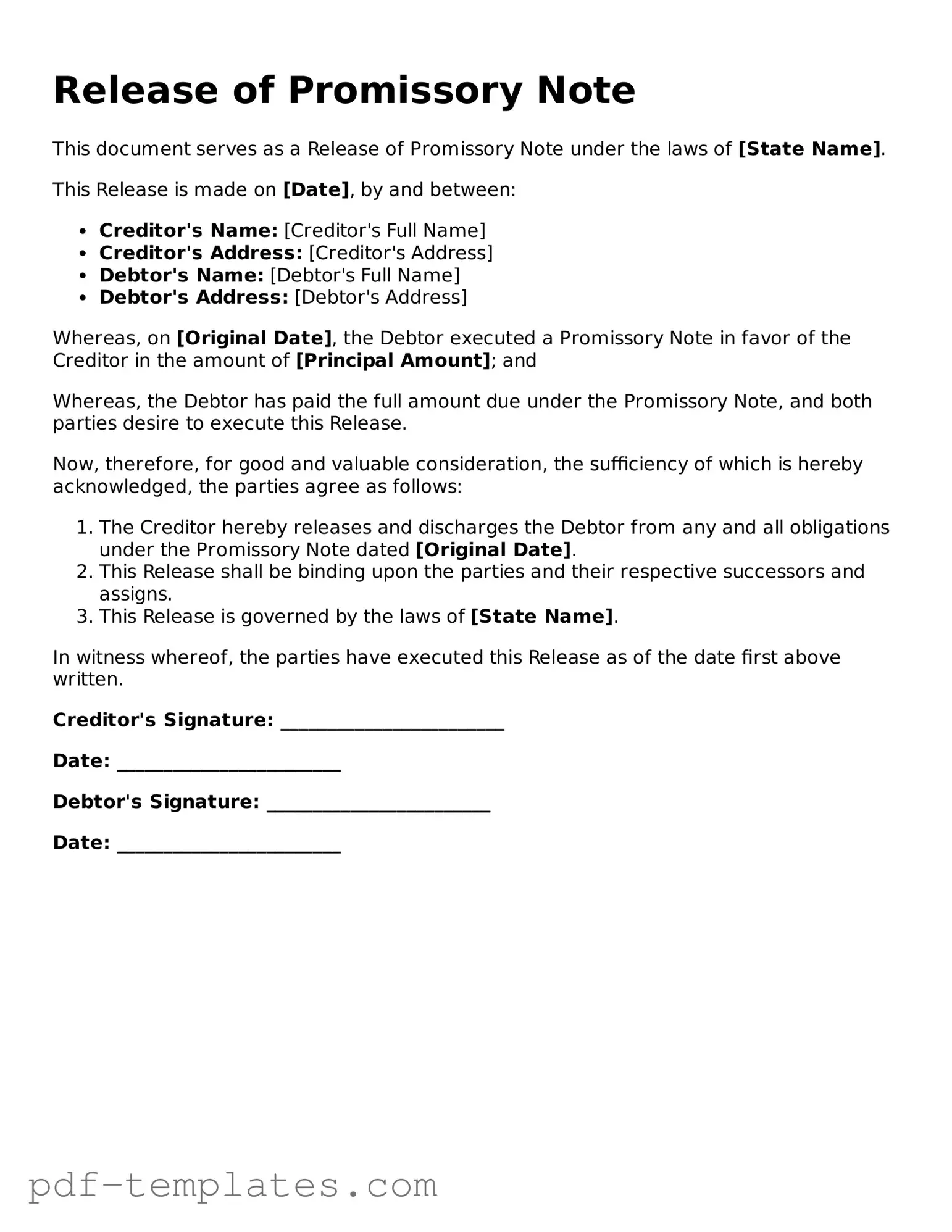The Release of Promissory Note form is closely related to the Satisfaction of Mortgage document. Both documents serve to signify the completion of a financial obligation. In the case of a Satisfaction of Mortgage, it indicates that the borrower has fully repaid their mortgage loan, thereby releasing the lien on the property. Similarly, the Release of Promissory Note confirms that the borrower has fulfilled their obligation under the promissory note, effectively nullifying the debt. Each document provides legal proof that the respective debts have been settled, offering peace of mind to the parties involved.
The importance of these financial documents cannot be overstated, as they provide necessary clarity in transactions. For those needing to create or manage these documents, resources such as the editable template available at https://formcalifornia.com/editable-promissory-note-form/ can facilitate the process and ensure all legal requirements are met.
Another document that shares similarities with the Release of Promissory Note is the Deed of Reconveyance. This document is used in the context of a trust deed, where a borrower conveys property to a lender as security for a loan. Once the loan is paid off, the lender executes a Deed of Reconveyance, which transfers the title back to the borrower. Like the Release of Promissory Note, this document formally acknowledges that the borrower has met their financial obligations, thereby releasing them from the debt associated with the trust deed.
The Loan Payoff Statement also bears resemblance to the Release of Promissory Note. This document provides a detailed account of the outstanding balance on a loan, including any interest or fees due. Once the borrower pays off the loan, a Release of Promissory Note may be issued to confirm that the debt has been satisfied. Both documents serve as important records for borrowers, ensuring that they have fulfilled their financial commitments and can move forward without lingering obligations.
A similar document is the Certificate of Satisfaction. This document is often used in real estate transactions to confirm that a borrower has paid off their mortgage or other secured debts. Upon full payment, the lender issues a Certificate of Satisfaction, which serves to clear the borrower’s name from the debt. Much like the Release of Promissory Note, this certificate acts as a formal acknowledgment that the borrower has completed their payment obligations, thereby allowing them to proceed with future financial endeavors unencumbered.
The Termination of Lease Agreement is another document that parallels the Release of Promissory Note. While it primarily pertains to rental agreements, both documents signify the end of a financial obligation. When a lease is terminated, it indicates that the tenant has fulfilled their responsibilities under the lease, similar to how the Release of Promissory Note confirms the borrower has met their obligations. Both documents provide clarity and closure to the parties involved, ensuring that no further claims can be made regarding the respective agreements.
The Assignment of Debt is also related to the Release of Promissory Note. This document occurs when a lender transfers the right to collect a debt to another party. Once the debt is settled, a Release of Promissory Note is issued to confirm that the obligation has been fulfilled. Both documents emphasize the importance of clear communication and documentation in financial transactions, ensuring that all parties are aware of their rights and responsibilities.
The Notice of Default is another document that shares a connection with the Release of Promissory Note. While it typically indicates that a borrower has failed to meet their payment obligations, it is an important part of the overall debt process. Once a borrower rectifies the default by making payments, the Release of Promissory Note can be issued to confirm that the debt is now satisfied. Both documents highlight the importance of maintaining clear records and communication between borrowers and lenders.
The Subordination Agreement also has similarities to the Release of Promissory Note. This document is used when a lender agrees to subordinate their lien position to another lender. Once the primary debt is satisfied, the Release of Promissory Note is issued to confirm that the borrower has met their obligations. Both documents play a crucial role in establishing the hierarchy of debts and ensuring that all parties understand their rights and responsibilities in financial transactions.
Finally, the Release of Lien is akin to the Release of Promissory Note. A lien is a legal claim against property to secure payment of a debt. When the debt is paid off, the lender issues a Release of Lien to remove the claim on the property. Similarly, the Release of Promissory Note confirms that the borrower has fulfilled their obligation under the promissory note. Both documents serve to clear the borrower’s financial record, allowing them to move forward without encumbrances related to the settled debts.
